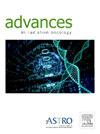前列腺立体定向全身放射治疗后结肠镜检查与胃肠道毒性和生活质量的相关性研究
IF 2.7
Q3 ONCOLOGY
引用次数: 0
摘要
目的:在前列腺立体定向放射治疗(SBRT)前进行结肠镜筛查(CS)可以识别同步恶性肿瘤和合并症胃肠道(GI)疾病。在放疗前进行这些手术排除了sbrt后骨盆内固定的必要性,后者可能导致严重的毒性和瘘管形成。我们回顾了CS的依从性、GI病理发生率,以及预处理CS结果对随后医生报告的毒性和患者报告的生活质量(QoL)的影响。方法和材料我们回顾了采用SBRT治疗前列腺癌患者的机构数据库,包括毒性和生活质量结果。我们详细回顾了CS预处理的发现,包括憩室病的识别、息肉切除的位置和痔疮的存在。然后,预处理CS结果与SBRT后的结果相关。结果发现消化道合并症是一个常见的事件,其中49.5% (n = 100)存在憩室病,67% (n = 136)存在痔疮,48% (n = 98)存在息肉。超过一半的息肉切除患者至少有一个息肉从直肠乙状结肠切除。预处理CS没有导致SBRT开始日期的延迟。在接近SBRT开始时接受CS的患者中,1级毒性显着降低。在憩室病、痔疮或息肉存在的情况下,医生分级的毒性风险没有增加。在我们的筛查队列中,患者报告的GI生活质量模式与之前发表的未筛查人群中所见的相似。在SBRT前有胃肠道病理的患者没有观察到明显的生活质量损害。结论在我们的老年患者群体中发现的gi病理是普遍的预处理CS。筛查CS可以优化接受放射治疗的患者的肠道健康。经预处理CS确定的胃肠道病变患者的毒性和生活质量不排除前列腺SBRT的递送。我们提倡在SBRT前对符合条件的患者进行预处理CS。本文章由计算机程序翻译,如有差异,请以英文原文为准。
Screening Colonoscopy Association With Gastrointestinal Toxicity and Quality of Life After Prostate Stereotactic Body Radiation Therapy
Purpose
Screening colonoscopies (CS) performed before prostate stereotactic body radiation therapy (SBRT) allow for identifying synchronous malignancies and comorbid gastrointestinal (GI) conditions. Performing these procedures prior to radiation precludes the necessity of post-SBRT pelvic instrumentation, which may lead to severe toxicity and fistulization. We review compliance of CSs, incidence of GI pathology, and the impact of pretreatment CS findings on subsequent physician-reported toxicity and patient-reported quality of life (QoL).
Methods and Materials
We reviewed an institutional database of patients treated for prostate cancer with SBRT including toxicity and QoL outcomes. A detailed review of pretreatment CS findings was reviewed including identification of diverticulosis, location of polyp resection, and presence of hemorrhoids. Pretreatment CS findings were then correlated with outcomes following SBRT.
Results
Identification of comorbid GI conditions was a common event, with the presence of diverticulosis in 49.5% (n = 100), hemorrhoids in 67% (n = 136), and polyps in 48% (n = 98). More than half of patients with polyps removed had at least 1 removed from the rectosigmoid. Pretreatment CS did not introduce a delay in SBRT start date. Grade 1 toxicity was significantly lower in patients who underwent CS closer to the initiation of SBRT. There was no increased risk of physician-graded toxicity in the presence of diverticulosis, hemorrhoids, or polyps. Patient-reported GI QoL pattern in our screening cohort mimicked that seen in the previously published nonscreened population. There was no overt QoL detriment observed in patients who had GI pathology identified before SBRT.
Conclusions
GI pathology identified in our elderly patient population was commonly identified on pretreatment CS. Screening CS may optimize bowel health for patients heading into radiation therapy. Toxicity and QoL for patients with GI pathologies identified on pretreatment CS do not preclude the delivery of prostate SBRT. We advocate for pretreatment CS in patients eligible prior to SBRT.
求助全文
通过发布文献求助,成功后即可免费获取论文全文。
去求助
来源期刊

Advances in Radiation Oncology
Medicine-Radiology, Nuclear Medicine and Imaging
CiteScore
4.60
自引率
4.30%
发文量
208
审稿时长
98 days
期刊介绍:
The purpose of Advances is to provide information for clinicians who use radiation therapy by publishing: Clinical trial reports and reanalyses. Basic science original reports. Manuscripts examining health services research, comparative and cost effectiveness research, and systematic reviews. Case reports documenting unusual problems and solutions. High quality multi and single institutional series, as well as other novel retrospective hypothesis generating series. Timely critical reviews on important topics in radiation oncology, such as side effects. Articles reporting the natural history of disease and patterns of failure, particularly as they relate to treatment volume delineation. Articles on safety and quality in radiation therapy. Essays on clinical experience. Articles on practice transformation in radiation oncology, in particular: Aspects of health policy that may impact the future practice of radiation oncology. How information technology, such as data analytics and systems innovations, will change radiation oncology practice. Articles on imaging as they relate to radiation therapy treatment.
 求助内容:
求助内容: 应助结果提醒方式:
应助结果提醒方式:


